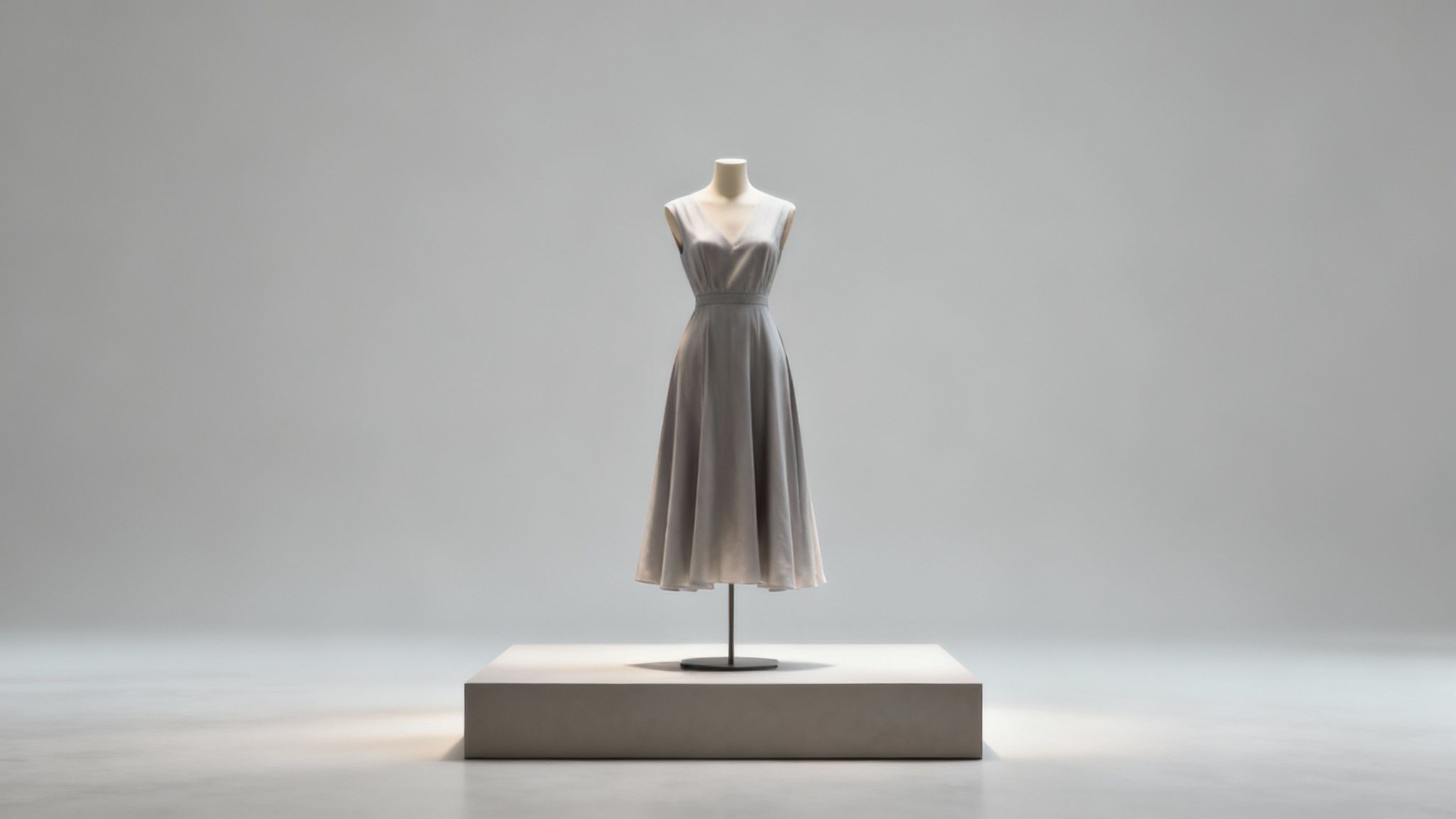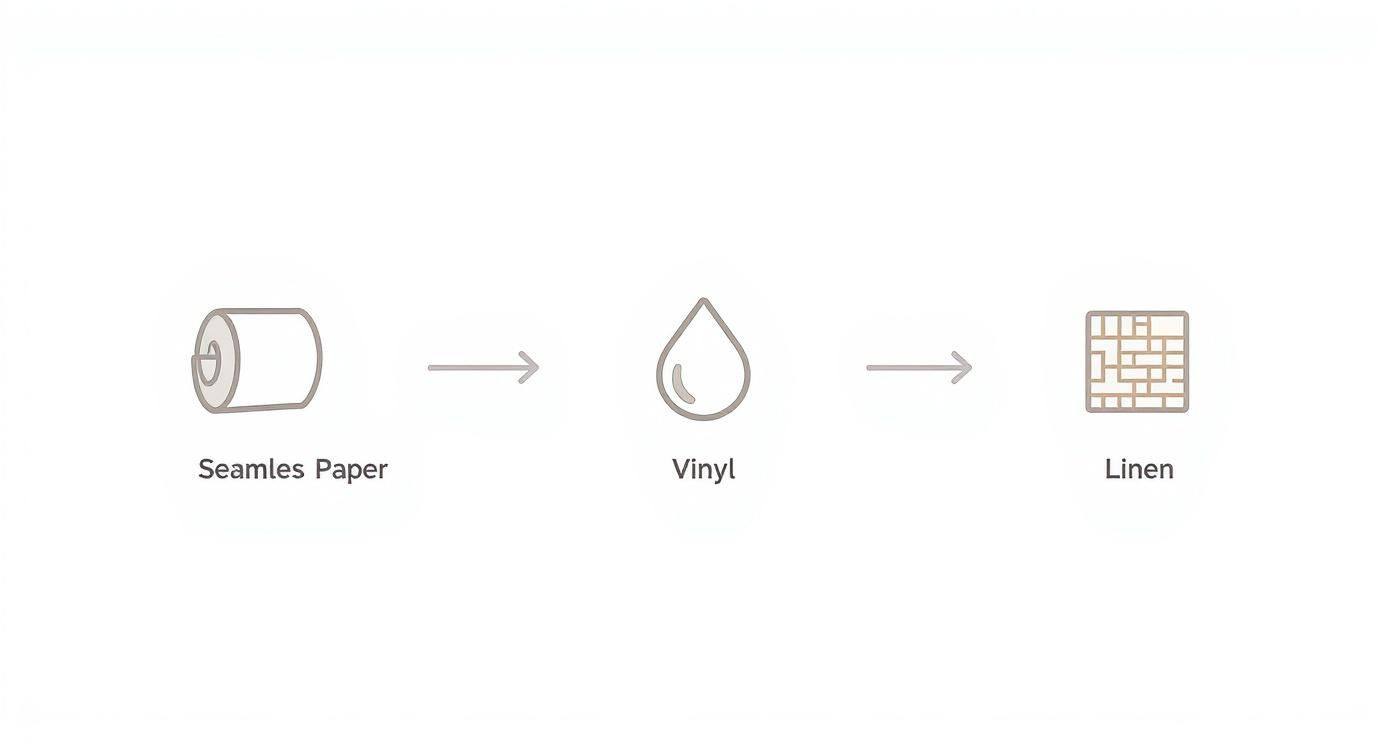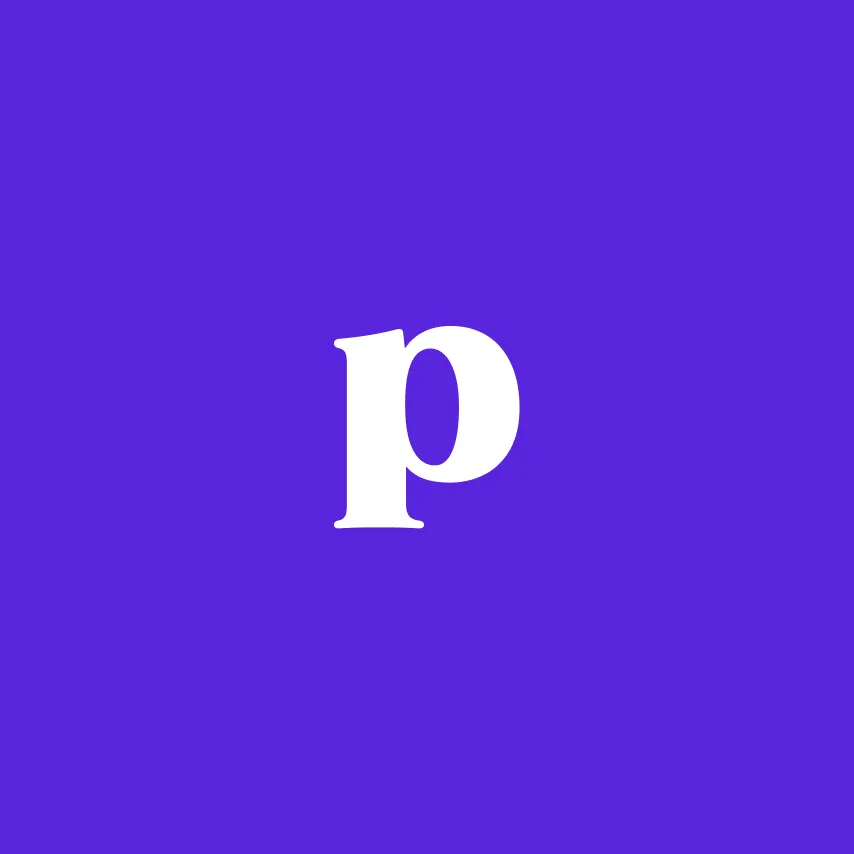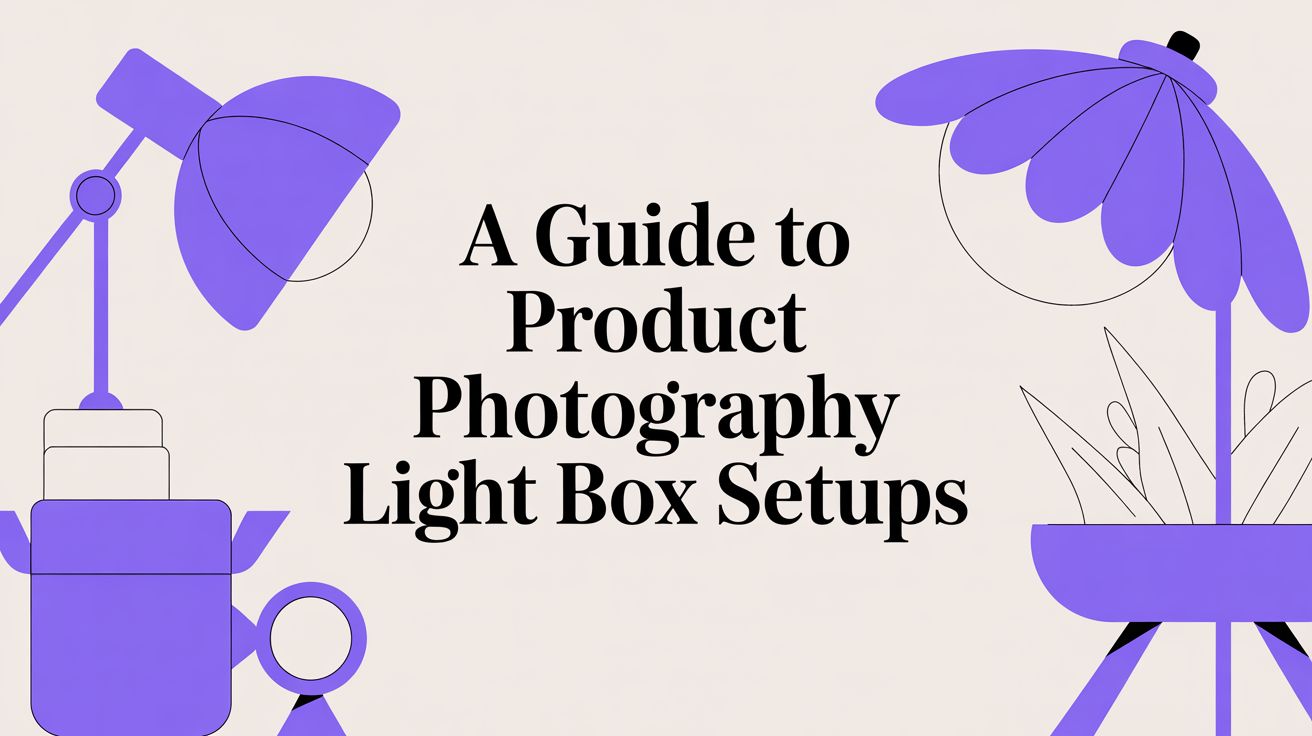How the Right Product Photography Backdrop Drives Fashion Sales
Elevate your brand with a concise guide to selecting a product photography backdrop. Learn materials, colors, and AI tips to scale your visuals.
How to start saving money
Lorem ipsum dolor sit amet, consectetur adipiscing elit lobortis arcu enim urna adipiscing praesent velit viverra sit semper lorem eu cursus vel hendrerit elementum morbi curabitur etiam nibh justo, lorem aliquet donec sed sit mi dignissim at ante massa mattis.
- Neque sodales ut etiam sit amet nisl purus non tellus orci ac auctor
- Adipiscing elit ut aliquam purus sit amet viverra suspendisse potent i
- Mauris commodo quis imperdiet massa tincidunt nunc pulvinar
- Adipiscing elit ut aliquam purus sit amet viverra suspendisse potenti
Why it is important to start saving
Vitae congue eu consequat ac felis placerat vestibulum lectus mauris ultrices cursus sit amet dictum sit amet justo donec enim diam porttitor lacus luctus accumsan tortor posuere praesent tristique magna sit amet purus gravida quis blandit turpis.

How much money should I save?
At risus viverra adipiscing at in tellus integer feugiat nisl pretium fusce id velit ut tortor sagittis orci a scelerisque purus semper eget at lectus urna duis convallis. porta nibh venenatis cras sed felis eget neque laoreet suspendisse interdum consectetur libero id faucibus nisl donec pretium vulputate sapien nec sagittis aliquam nunc lobortis mattis aliquam faucibus purus in.
- Neque sodales ut etiam sit amet nisl purus non tellus orci ac auctor dolor sit amet
- Adipiscing elit ut aliquam purus sit amet viverra suspendisse potenti
- Mauris commodo quis imperdiet massa tincidunt nunc pulvinar
- Adipiscing elit ut aliquam purus sit amet viverra suspendisse potenti
What percentage of my income should go to savings?
Nisi quis eleifend quam adipiscing vitae aliquet bibendum enim facilisis gravida neque. Velit euismod in pellentesque massa placerat volutpat lacus laoreet non curabitur gravida odio aenean sed adipiscing diam donec adipiscing tristique risus. amet est placerat imperdiet sed euismod nisi.
“Nisi quis eleifend quam adipiscing vitae aliquet bibendum enim facilisis gravida neque velit euismod in pellentesque massa placerat”
Do you have any comments? Share them with us on social media
Urna ut fermentum imperdiet lacus, elementum etiam maecenas libero nunc, suspendisse massa, nisl, elit curabitur feugiat in quis ut nibh enim in tristique aliquam sed vitae dui, dis adipiscing pharetra aliquam turpis turpis nibh rhoncus enim, pellentesque leo laoreet neque in sed bibendum fermentum suspendisse tempus non purus adipiscing suscipit fringilla adipiscing convallis dolor nulla fermentum facilisis ullamcorper ut vehicula tortor libero metus donec velit, tristique fermentum, dictum euismod diam scelerisque enim non pharetra tristique lectus habitant pharetra est id
A solid product photography backdrop is the unsung hero of any fashion e-commerce store. When luxury brand The Row shoots its minimalist collections against a simple, textured wall, it’s a deliberate choice to telegraph quality. This is how a backdrop transforms from a simple background into a strategic tool that elevates your clothing, tells a brand story, and drives conversions.
Why Your Backdrop Choice Directly Impacts Revenue

Consistent visuals build trust. When you see a signature look from a brand like Reformation or Everlane, it’s no accident. Their consistent use of clean, often neutral backdrops makes every product feel professional and curated.
The right background kills distractions, forcing the customer's eye to the product’s details — the texture of a knit sweater, the tailoring of a blazer, or the vibrant color of a silk dress. That clarity is everything.
A McKinsey report notes that strong visual identity can increase revenue by over 30%. Your backdrop is a core part of that identity, and platforms like Picjam allow brands to create thousands of on-brand, high-quality scenes without the cost of physical photoshoots.
For many top apparel brands, simplicity converts best. A huge 47% of clothing brands worldwide stick to clean white studio backgrounds to boost sales. Why? It creates a neutral canvas that makes the product the undisputed star. You can dig deeper into these apparel industry trends.
How to Match Your Backdrop to Your Brand Goal
Picking a backdrop is a strategic move tied to what you're trying to achieve. Different backgrounds do different things, whether highlighting product features or creating an aspirational vibe for a campaign.
A seamless white or gray paper backdrop is the workhorse for high-converting product detail pages (PDPs). It’s the industry standard for a reason: it’s clean, professional, and puts all the focus squarely on the garment.
On the other hand, a textured backdrop tells a story. Picture a luxury cashmere brand like Naadam using a soft, warm-toned setting to evoke comfort, or a streetwear brand like Aimé Leon Dore using a gritty, urban-inspired wall to communicate an edgy, modern vibe.
The table below is a cheat sheet for aligning your backdrop choice with your brand's specific sales and marketing goals.
Ultimately, the goal is to make a conscious choice. Are you trying to sell the product's features, or are you selling a feeling? Your backdrop is the first step in answering that question.
Choosing Physical Backdrop Materials and Colors
Picking the right physical backdrop is a tactical move. The material you land on has a direct ripple effect on your workflow, your budget, and how customers perceive your clothing's quality.
Think about it: the material behind your product sets a tone. A brand like AllSaints, known for its premium leather, gets more mileage out of a soft, textural linen background than a plain paper roll. It telegraphs quality instantly.
Material Breakdown for Top Fashion Brands
The 4 most common materials all have their pros and cons, and the right choice really depends on what you're shooting.
- Seamless Paper: This is the undisputed industry workhorse. It’s affordable, comes in a million colors, and gives you a perfectly smooth, non-reflective surface. It’s perfect for cranking out clean, consistent e-commerce shots at high volume.
- Vinyl: A total lifesaver if you're shooting things that can scuff or stain, like shoes or accessories. Vinyl is incredibly durable, waterproof, and wipes clean in seconds.
- Linen/Canvas: These fabrics bring a sense of warmth, craft, and luxury. They’re a fantastic match for brands that focus on natural fibers or want to cultivate a rustic, high-end vibe. The catch is they wrinkle and demand careful steaming before every shoot.
- Hard Surfaces: We're talking about painted wood planks, concrete slabs, or marble tiles. These are killer for smaller flat lays or accessory shots, adding an authentic, tangible feel that connects with lifestyle branding.
How to Select Colors Strategically
Color is a massive brand signal. Neutrals are the safe, classic play, but the right color can capture an entire market segment. Look at Glossier’s iconic use of millennial pink — they built a whole identity around a signature color.
For most apparel brands, a core set of neutral backdrops is non-negotiable for creating timeless product photos.
A soft gray or off-white backdrop often feels more sophisticated than stark white. These tones are less clinical, feel warmer, and can make the colors in your apparel look richer.
But don't sleep on bold, saturated colors. They can be an incredible tool for social media campaigns, especially if you’re trying to grab the attention of a Gen Z audience. The trick is making sure the color complements your collection and doesn't just swallow the product. If you want more tips on making your images pop, check out our guide on generating high-quality product photos.
A Quick Checklist for Your Decision
Before you pull the trigger on a new product photography backdrop, run through these questions:
- What’s my product? Delicate silks and rugged boots need very different surfaces.
- What’s my budget? Paper is cheap; vinyl is a more durable one-time buy.
- What’s my brand aesthetic? Are you minimalist and modern, or rustic and handmade?
- How much space do I have? Big paper rolls need stands, while smaller boards are more portable.
Answering these will point you toward a backdrop that not only looks great but actually works with your production process.
Mastering Lighting for Any Backdrop
An incredible backdrop is only half the battle. Your lighting setup is what really separates an amateur, flat-looking image from a professional shot that practically screams texture and quality.
You’ve got 2 main options: natural light and studio light. Natural light from a big window can give you a soft, diffused look perfect for lifestyle brands. The catch is that it's wildly inconsistent, making it a headache to keep a uniform look across your catalog.
Studio lighting is where you get total control.
This flow chart breaks down how different physical backdrop materials fit with specific photoshoot needs, helping you nail the right surface for your next project.

As you can see, seamless paper gives you versatility, vinyl brings the durability, and linen adds that touchable texture. It's all about matching the material to your brand's aesthetic and the specific product you're shooting.
Studio Lighting Setups That Work
For consistent, repeatable results, studio lighting — using strobes or continuous LEDs — is the industry standard. This is how you get that polished, professional look every single time.
Let's say you're shooting a delicate silk dress for a brand like Cuyana. You need your lighting to highlight the fabric's subtle sheen without creating harsh, distracting shadows.
A simple one-light setup using a large softbox can work wonders. Placed at a 45-degree angle to the product, this single source acts as your key light, defining the garment's shape and texture with beautiful, soft light.
To take it up a notch, add a second light. A fill light, positioned on the opposite side at a lower power, gently opens up the shadows cast by your key light. This two-light setup is a workhorse for a clean, balanced look.
But for maximum control, a three-light setup is the gold standard.
- Key Light: This is your main light source, doing the heavy lifting to create shape and dimension.
- Fill Light: A softer, secondary light that dials back any harsh shadows.
- Backlight (or Rim Light): Positioned behind the product, this one is a game-changer. It cleanly separates the item from the product photography backdrop, adding depth and a subtle, high-end glow.
For smaller products like accessories or footwear, a dedicated light box is an incredibly efficient way to get perfectly diffused, even lighting. If that's your niche, our deep dive into the benefits of a product photography light box can seriously streamline your workflow.
Embracing Sustainable and Thematic Backdrops
Today’s shoppers buy into brands that align with their values. Your product photography backdrop is a powerful way to show people what you stand for, long before they read your "About Us" page.
This shift toward more purposeful visuals is a huge opportunity. The materials you choose can instantly telegraph a commitment to sustainability, a major factor for a growing number of consumers.
How to Weave Sustainability into Your Visuals
Outdoor and lifestyle brands have this down to a science. Take a brand like Patagonia. Their product shots are almost always set against natural, rugged elements like reclaimed wood or earthy textures. It’s a deliberate choice that reinforces their eco-conscious mission.
You can adopt this same mindset easily. Here are a few sustainable options to consider for your next shoot:
- Recycled Paper Rolls: Many seamless paper brands now offer rolls made from recycled materials. You get the same professional look with a smaller environmental footprint.
- Reclaimed Wood or Stone: Perfect for smaller products and flat lays. Sourcing reclaimed materials from local suppliers adds authentic texture and a genuine sustainability story.
- Natural Fabrics: Think unbleached linen or organic cotton. These can create a soft, high-end vibe that’s a perfect match for brands focused on natural fibers and craftsmanship.
This isn't a fleeting trend. Industry forecasts predict that by 2025, the demand for eco-friendly backdrops will grow significantly, driven by consumers wanting brands to be more responsible. You can explore more product photography trends to see just how big this shift is becoming.
The Power of Thematic Backdrops
Beyond the material, the theme of your backdrop is your secret weapon for creating a specific mood. This is where you build a world around your product. A minimalist concrete wall screams urban and modern, perfect for a streetwear brand. A soft, sun-drenched room instantly captures the relaxed vibe of a coastal lifestyle collection.
Think of your backdrop as a set piece in your brand’s film. It sets the scene and establishes the mood. The right theme can boost engagement by making your product feel more aspirational and relatable.
Your backdrop stops being a passive element and becomes an active part of your brand's narrative. It’s a strategic move that forges a deeper, more memorable connection with your customers.
How AI Backdrops Cut Content Costs by up to 80%
While physical backdrops have their place, they come with serious limitations: they're expensive, take up space, and aren't flexible for rapid content needs. AI-powered virtual solutions are changing the game for modern fashion brands.
Tools like Picjam are built to cut out the friction of a traditional photoshoot. Forget about location scouting, backdrop rentals, or spending hours on setup.
The real win here is the one-two punch of savings and speed. Picture a major retailer like Zara wanting to test a new handbag collection against 10 different urban backdrops — maybe a Parisian café, then a sunlit street in Milan.
That kind of shoot would traditionally demand a massive budget and weeks of coordination. With an AI workflow, a creative team can generate all 10 of those high-quality scenes in minutes, starting with a single, clean product shot. According to Vogue Business, brands are already seeing content production savings of up to 80% with AI tools.
The Financial Impact: Physical vs. AI Backdrops
The money spent on physical props is significant. The global photography props market, which includes the product photography backdrop category, was valued at around $1.8 billion in 2023. It's projected to climb to $3.2 billion by 2032.
AI offers a direct way to bypass these rising costs. Instead of buying and storing physical backdrops, you can generate unlimited virtual scenes perfectly tailored to any campaign, collection, or fleeting trend.
For a quick comparison, a single high-quality 9-foot seamless paper roll costs about $70. A brand needing 10 different colors is already looking at a $700 bill — before factoring in stands, storage, and replacements. An AI subscription, on the other hand, offers infinite variations for one fixed monthly fee.
This changes the economics of content creation, allowing smaller brands to compete with the visual polish of established fashion houses without the crippling upfront investment.
How AI Scales Creative Output
The savings are a huge draw, but the creative freedom is where AI truly shines. With virtual backdrops, your only limit is your imagination. A fashion brand can instantly place a winter coat in a snowy alpine setting or showcase a summer dress on a tropical beach — all without booking a single flight.
This agility is essential for keeping up with fast-moving trends. If an aesthetic like "coastal grandmother" suddenly blows up on TikTok, you can generate on-point lifestyle imagery in hours, not weeks.
If you're curious about the technical side, getting good at prompt engineering is key. For some practical tips, you can learn how to get ChatGPT to generate images to nail the look you're going for. This skill allows creative teams to fine-tune outputs for specific campaign needs.
By knocking down the logistical barriers of physical shoots, AI empowers brands to experiment more freely. You can test dozens of visual concepts to find what really clicks with your audience, optimizing every campaign for maximum engagement and conversion. To see how this works for fashion specifically, check out our guide on AI product photography.
Takeaway
Here are 3 actionable steps to elevate your brand’s visual strategy today:
- Audit Your Visuals Against a Competitor: Pull up your site next to a top competitor. Honestly assess if your backdrops communicate the same level of quality and brand story. Identify one specific gap to address in your next shoot.
- Test One New Backdrop Material: If you always use seamless white paper, try a textured linen for knitwear or a durable vinyl for accessories. A small change can significantly alter a product's perceived value.
- Calculate Your Potential AI Savings: Use an AI savings calculator to compare the cost of your last physical photoshoot against the expense of generating those same assets virtually. Seeing the numbers can reframe your entire content budget.
Ready to see how the numbers stack up for your brand? Compare your current photography costs with Picjam’s AI solution using our savings calculator.
Calculate Your Savings Now
Picjam team
Pellentesque leo laoreet neque in sed bibendum fermentum suspendisse tempus non purus adipiscing suscipit fringilla adipiscing convallis dolor nulla fermentum facilisis ullamcorper ut vehicula tortor lib.



